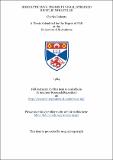Files in this item
Homolytic ring fission in small, strange bicyclic molecules
Item metadata
| dc.contributor.advisor | Walton, J. C. (John Christopher) | |
| dc.contributor.author | Roberts, Charles | |
| dc.coverage.spatial | ix, 134 p. | en_US |
| dc.date.accessioned | 2018-07-16T15:33:15Z | |
| dc.date.available | 2018-07-16T15:33:15Z | |
| dc.date.issued | 1984 | |
| dc.identifier.uri | https://hdl.handle.net/10023/15442 | |
| dc.description.abstract | The homolytic ring fission of strained bicycloalkyl radicals was investigated by E.S.R. spectroscopy. These bicycloalkyl radicals provided examples of cycloalkyl-, cyclopropylmethyl-, and cyclobutylmethyl-type radicals in which the preferred mode, and rate of β-scission could be studied. Three types of compounds were investigated; i.e. (i) bicyclo[n.1.0]alkanes, where n = 3-6; (ii) spiro[2.n]alkanes, where n = 3,4; and (iii) spiro[3.3]heptanes. Observations on the corresponding radicals enabled the influence of; (a) ring size (and consequent ring strain), and (b) the orientation of the SOMO on the rearrangement to be assessed. The series of bicyclo[n.1.0]alk-2-yl radicals, where n = 3-6, were found to undergo β-scission of the outer cyclopropane bond to give the corresponding cycloalkenylmethyl radical. Ring fission was very rapid, and only the rearranged radicals could be detected in the accessible temperature range. In contrast, the first two members of the series (n = 1,2) rearranged by fission of the internal cyclopropane bond to give cycloalkenyl radicals. The conformations of the rearranged cycloalkenylmethyl radicals were determined from the temperature dependance of the β-hydrogen h.f.s., and were interpreted in terms of steric effects. The geometries of the radical species, their enthalpies of activation, and the enthalpies of reaction were calculated by semi-empirical MNDO computations. Photobromination of the n = 3 and n = 4 bicycloalkanes was carried out. The major products were identified and analysed. The main process in each case was homolytic displacement by bromine atoms with consequent fission of the outer cyclopropane bond. This SH2 reaction showed a clear parallel to the β-scission in the series of radicals. However, the change in the mode of fission from internal to outer cyclopropane bond with increasing ring size was less clear cut. Hydrogen abstraction from the spiro[2.n]alkanes gave SFd.ro[2.n]alk-4-yl radicals which ring open in one mode only to give cycloalkenylethyl radicals. The rate of β-scission increased greatly from the n = 2 to the n = 3 to the n = 4 member of the series. With spiro[2.3]hex-4-yl radicals both unrearranged and rearranged radicals were detectable. The Arrhenius parameters for the rearrangement were determined from measurements on the concentrations of the two species. The conformations of the ring opened cycloalkenylethyl radicals were deduced from the temperature dependance of the β-hydrogen h.f.s. The photobromination of spiro[2.3]hexane gave mainly 1-bromo-1-(2-bromoethyl)cyclobutane and 1,1-bis(bromomethyl)-cyclobutane from the SH2 attack of bromine atoms at the cyclopropane n carbon atom. Semi-empirical MNDO calculations were carried out to predict the enthalpies of activation, and the enthalpies of reaction for the rearrangements. Bromine abstraction from 2-bromomethylspiro[3.3]heptane gave rise to a cyclobutylmethyl like radical, namely the spiro-[3.3]heptane-2-methyl, radical. This radical rearranged via β-scission to a 1-(prop-2-enyl)cyclobutylmethyl radical. Both unrearranged and rearranged radicals were detectable. As with spiro[2.3]hex-4-yl radicals the Arrhenius parameters for the rearrangement were determined. The enthalpy of activation, and the enthalpy of reaction were also calculated by semi-empirical MNDO ccmputations. The conformation of the unrearranged radical was determined from the temperature dependance of the β-hydrogen h.f.s. Attempts to generate spiro[3.3]hept-1-yl radicals from spiro[3.3]heptane were unsuccessful due to the failure to prepare spiro[3.3]heptane. The spiro[3.3]hept-2-yl radical was however observed. This radical did not undergo β-scission. With the cyclobutylmethyl-, and cyclopropylmethyl like radicals β-scission was observed to occur in a stereoelectronically allowed manner. Overall this study has confirmed that the major influence in the ring fission of cycloalkylmethyl radicals is the stereoelectronic effect. Thus orbital interaction, through maximised overlap, is a prerequisite to β-scission of both cyclopropylmethyl- and cyclobutylmethyl-like radicals. The study of spiro[2.n]alkanes revealed that ring size may affect the rate of ring fission by way of a conformational effect. | en_US |
| dc.language.iso | en | en_US |
| dc.publisher | University of St Andrews | |
| dc.subject.lcc | QD461.R7 | |
| dc.subject.lcsh | Molecular theory | en |
| dc.title | Homolytic ring fission in small, strange bicyclic molecules | en_US |
| dc.type | Thesis | en_US |
| dc.type.qualificationlevel | Doctoral | en_US |
| dc.type.qualificationname | PhD Doctor of Philosophy | en_US |
| dc.publisher.institution | The University of St Andrews | en_US |
This item appears in the following Collection(s)
Items in the St Andrews Research Repository are protected by copyright, with all rights reserved, unless otherwise indicated.

